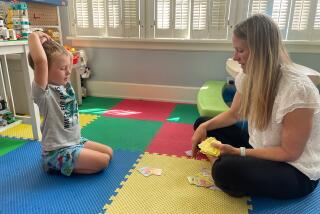More Time Together
- Share via
Parents still obsessing about the quality-versus-quantity time conundrum can relax.
Both working and stay-at-home moms spend slightly more time caring for their children than their own mothers did, and dads spend almost twice as much time as their fathers did, according to a University of Maryland researcher and family demographer.
Mothers spent an average of 5.8 waking hours a day with their children in 1998, compared with 5.6 in 1965, despite the fact that the percentage of mothers employed outside the home has nearly doubled in the last 30 years, according to a new study of more than 1,200 people across the country.
Meanwhile, the time fathers spent with their children almost doubled, from 2.7 hours in 1965 to four hours a day in 1998.
“For a long time, family researchers have been looking for negative effects of maternal employment on children,” said Suzanne Bianchi, a coauthor of the study. Bianchi was in Los Angeles over the weekend for a gathering of the Population Assn. of America, of which she is president. “And some studies have found effects for specific time periods or groups--the first year of life or middle-class sons--but always very small and not necessarily borne out by the overall literature.”
How can this be? Well, for the mothers in the audience, the answers may seem obvious: Modern mothers in general do less housework (as much as six fewer hours a week), and employed mothers report getting five to six fewer hours of sleep and having 12 fewer hours of free time than their non-employed peers do.
Although a study quantifying their experience may not buy them any more downtime, Los Angeles mothers appreciate the validation.
“I’m glad to hear about it,” said Carla Ford, a lawyer for the U.S. Attorney’s office in downtown Los Angeles and mother of 2-year-old Nicholas.
Ford leaves for her 50- to 60-hour-a-week job about 7 a.m. Her husband, Michael Kinberg, is a screenwriter and works from their Los Angeles home; by the time Ford returns home, he is usually preparing dinner so she can spend time with Nicholas.
“We play on the computer or with his blocks,” Ford said. “It’s great [that] when I come through the door, I don’t have to put on my apron.”
Bianchi’s results come as no surprise to Cindy Wilson, an office manager of a law firm and the mother of two kids, who says children change a person’s priorities, including sleep patterns and leisure choices.
“I think any parent immediately becomes less self-absorbed,” said Wilson, who lives in Palos Verdes Estates with her husband, Chris, and two children, Kristina, 13, and Scott, 10. Her dedication to family time has taken on a slightly heroic cast, since a favorite family outing is 5K runs.
“I walk them, and I enjoy the scenery,” she said.
Margo Lyons, an administrative assistant at UCLA Medical Center and the mother of girls ages 11 and 25, said her daughters come first.
“My kids have always been my priority,” the Chatsworth resident said. “I never feel like I give up things to be with them. . . . We do everything together.”
Other working mothers say they sacrifice home-cooked meals and squeaky-clean kitchen floors to ensure that their at-home time is spent with their kids.
“The decline in housework is very dramatic,” Bianchi said. “The time spent with children is not. Women decide what their priorities are, what is most precious, and at the top of the precious list is time with their children.”
Extra effort on the part of parents is not the only factor at work, however. Just as important, Bianchi said, is the decrease in average family size and an increase in mothers’ educational levels.
“The working mother in 1965 was more likely to be high-school educated, with four or five kids,” Bianchi said. “So first of all, her attention was more divided. And the research indicates that the more highly educated the mother, the more time they spend directly with their children.”
Working mothers do spend less time with their children than their stay-at-home counterparts, although the discrepancy is not as large as many might think--about 15% over a typical 18 years.
These findings emerged from a study Bianchi and colleague John Robinson conducted to discover what, exactly, Americans do in their non-work time. Using a 1965 time-diary study done by researchers at the University of Wisconsin as both a model and a comparison, they did telephone interviews with 1,200 men and women around the country, asking them to “walk through” their previous day, describing exactly what they did at what time, and who was with them when they did it. The time-diary approach is considered more reliable in charting people’s actual activities than merely asking them how much time they spent doing this or that, which often elicits responses that overestimate time, Bianchi said.
“Time with children is especially hard,” she said “because so much of it comes in snippets. And people can unintentionally skew the numbers if they know you are asking about children, because of the emotional attachment.”
*
But Bianchi, whose work has long dealt with family and gender issues, was particularly eager to ascertain the figures dealing directly with mothers and children.
Her determination was sharpened, she said, by a commencement speech President Clinton gave last year at Grambling State University in Louisiana. Quoting a new study by his Council of Economic Advisers, Clinton claimed that parents now spend 22 fewer hours each week at home.
“The implication was that these were fewer hours parents would spend with their children,” Bianchi said. “They were simply subtracting the additional hours spent in the workplace from an assumed number of hours spent with children. We have these assumptions, and I was interested in finding out exactly what was happening in that time.”
One thing she discovered is that we may have overestimated the time mothers spent with their children in the past.
Citing a 1996 study done by researchers at Cornell and the University of Utah, Bianchi claims that the time mothers spent with their children was virtually unchanged from the 1920s until the 1970s, when it began showing a slight increase, probably because of decreased family size. Even though most of these women were stay-at-home mothers, Bianchi said, much of their time was spent in very real domestic work--young children were often cared for by an older sibling or grandparent.
“I am a baby boom child,” she said. “And my mother looks at my husband and me and says, ‘I wish I could have done the things you do with your three.’ Which is shocking to me since she was a stay-at-home mom, but then she had six of us.”
Bianchi does not believe that her studies are by any means definitive--her limited data do not enable her to draw any conclusions about the effects of race or culture on family trends--factors she believes are probably very important. She and Robinson are in the midst of another, similar study with a broader participation base, and she hopes her presentation at last week’s conference will help generate interest in these issues.
She said her findings do seem to be borne out by similar studies at universities around the world.
But she also wants to take the discussion one step further.
“The bigger question that I haven’t answered is: So what? How correlated is time [spent] with children with how well they turn out? That will be a very difficult thing to measure.”
*
Mary McNamara can be reached at mary.mcnamara@latimes.com, Martin Miller at martin.miller@latimes.com.







